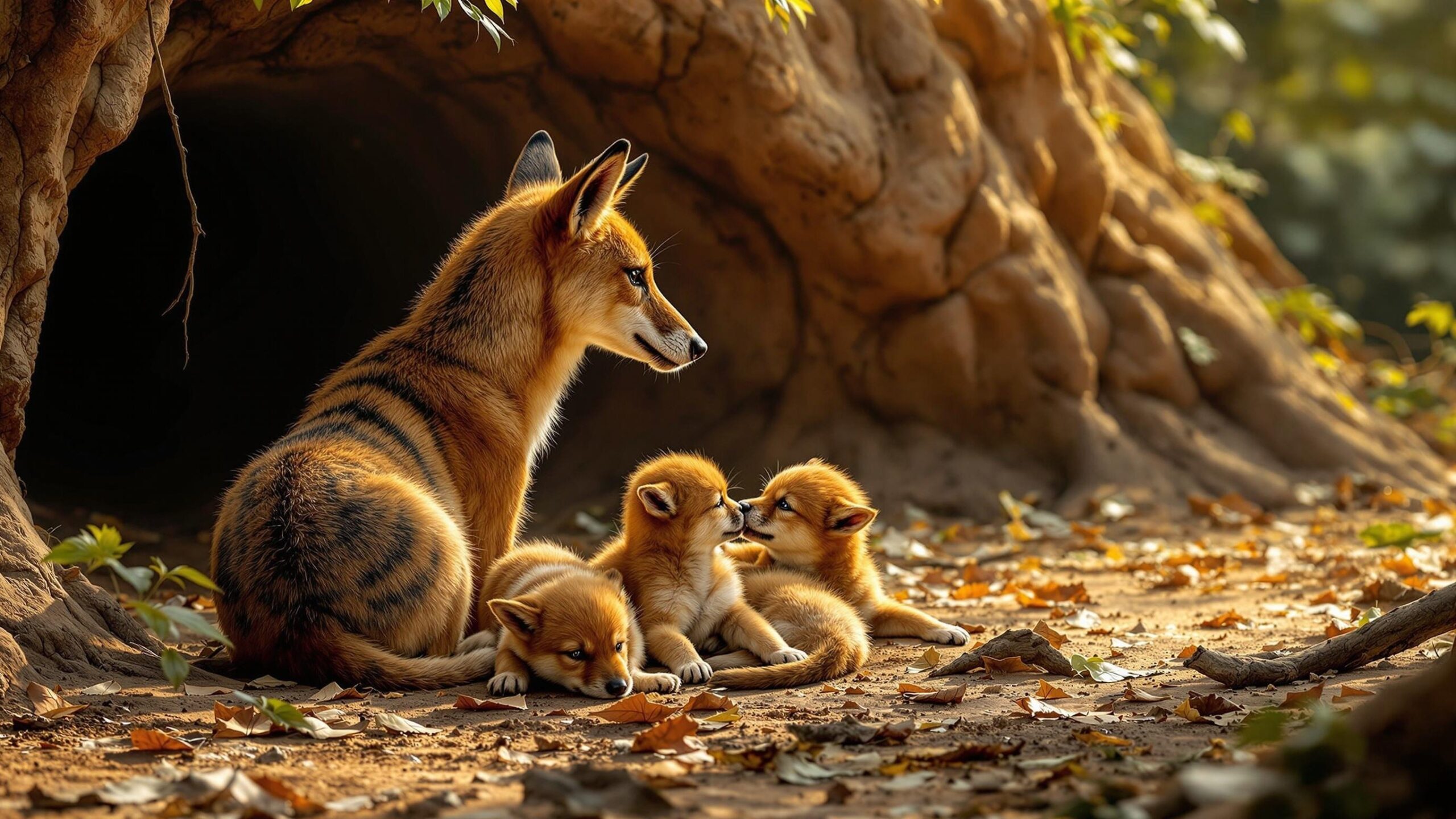Dholes: The Whistling Hunters of Asia’s Forests
In the lush, dappled forests of India, through bamboo groves, alpine meadows, and montane thickets, a reddish-brown blur streaks between trees. It moves fast—low to the ground, alert, and focused. Soon another appears, and another. They communicate not with howls or barks but with high-pitched whistles that rise like birdcalls. This is no ordinary predator. This is the dhole—Asia’s enigmatic wild dog and one of nature’s most coordinated hunters.
Known scientifically as Cuon alpinus, and sometimes referred to as the Asiatic wild dog, red dog, or whistling dog, the dhole is a lesser-known but utterly fascinating canid species native to Central, South, and Southeast Asia. While often overlooked in favor of more famous carnivores like tigers or wolves, the dhole is an extraordinary example of social intelligence, adaptability, and ecological importance. To explore the world of dholes is to step into the dense green tapestry of Asia’s wild lands, where teamwork reigns supreme and communication sounds like song.
The Identity of a Dhole: Biology, Communication, and Intelligence
Dholes are medium-sized canids, typically weighing between 25 and 45 pounds. They are lean and muscular, with a thick ruddy coat that becomes paler in summer and darker in winter, depending on their habitat’s latitude. Their bushy black-tipped tails and large, rounded ears give them a foxlike appearance, but their behavior more closely mirrors that of wolves or African wild dogs. Perhaps the most distinctive characteristic of the dhole is its vocalizations. Unlike wolves that howl or jackals that bark, dholes produce an eerie whistle used to coordinate group movements, especially during hunting. This signature call has earned them the nickname “whistling hunters,” and it is believed to be incredibly effective in dense forests where visibility is limited but sound travels easily. Socially, dholes live in cohesive packs that typically consist of 5 to 12 individuals but may sometimes include up to 30. They operate within complex social structures built around cooperation, with strong bonds formed between individuals. Unlike wolves, where typically only the alpha pair breeds, dhole packs often allow multiple females to reproduce, increasing their chances of raising surviving offspring in an unpredictable environment.
The Range of the Red Dog: Where Dholes Call Home
Historically, dholes were widespread across much of Asia—from the Russian Far East and Korea through China, down into the Himalayas, India, Southeast Asia, and even as far as Indonesia. Today, however, their range has been dramatically reduced. Habitat loss, disease, and competition with humans have restricted dholes to fragmented populations primarily in India, Bhutan, Nepal, Myanmar, Thailand, Malaysia, and some parts of China.
In India, which harbors the largest remaining population of dholes, they are found in several protected reserves, including Nagarhole, Bandipur, and Tadoba in the south, and Kanha and Pench in central India. These mixed forests, teeming with deer, wild boar, and gaur, provide ideal hunting grounds. Dholes here are known for their daring behavior—occasionally chasing prey into water or even challenging a lone tiger over a kill.
In Southeast Asia, dholes inhabit tropical evergreen and monsoon forests, often in hilly or mountainous areas. Although sightings are rare, camera traps and DNA surveys confirm their continued presence in places like Thailand’s Huai Kha Khaeng Wildlife Sanctuary and Malaysia’s Taman Negara. These populations, however, are under constant pressure from habitat encroachment and reduced prey density.
Pack Tactics: The Dhole’s Extraordinary Hunting Strategies
Dhole hunting is a masterclass in coordination. Unlike ambush predators such as leopards or solitary canids like jackals, dholes rely on stamina, strategy, and collaboration. A typical hunt begins with the pack fanning out to locate prey—often deer species such as chital, sambar, or muntjac. Once a target is selected, the pack gives chase, maintaining relentless pressure over long distances. Their stamina and ability to rotate positions allow them to wear down prey animals through sheer persistence. What sets the dhole apart is their group execution. While one or two dogs harass the rear of a fleeing deer, others may circle ahead, cutting off escape routes. The whistles and chirps they emit help maintain contact and timing in thick brush. Once the prey is downed, the pack consumes it rapidly, sharing without the aggression seen in many other carnivores.
Their hunting success rate is high, especially in open forests, and they are bold enough to confront much larger prey such as wild boar or even gaur calves. When prey is scarce, dholes have been observed scavenging or hunting smaller animals like hares, birds, or rodents. This flexibility underscores their role as ecological regulators, maintaining prey balance and contributing to the health of their environment.
Sub-Populations and Habitat Adaptations Across Asia
Within the broad category of dholes, regional adaptations have shaped subtle behavioral and physical differences among populations. In the Western Ghats of India, dholes tend to form larger packs and hunt bigger prey due to relatively high prey density. These areas also have denser forests and higher rainfall, affecting how dholes vocalize and how far they travel. Packs here are often more stable year-round, thanks to consistent prey availability and well-protected reserves.
In the Eastern Himalayan foothills, dholes navigate steep terrain and colder climates. Their winter coats become thick and dense, and they rely more on mid-sized prey like goral and serow. These areas are often shared with red pandas, Himalayan black bears, and snow leopards, making it a region of high biodiversity and intense predator dynamics.
In the tropical forests of Southeast Asia, dholes must contend with fragmented landscapes and heavily hunted prey populations. Packs tend to be smaller, and sightings are rarer. Nonetheless, field researchers have documented their presence in areas like Myanmar’s Hkakabo Razi and Thailand’s Western Forest Complex, giving hope that these elusive canids continue to adapt and persist despite immense pressure.
Raising the Next Generation: Dhole Reproduction and Denning Behavior
Dholes breed once a year, usually between October and January, with births occurring around two months later. The mother gives birth in a den—often an abandoned burrow, rocky crevice, or hollow tree stump—which she lines with grass and leaves. A typical litter includes 4 to 10 pups, though larger litters have been recorded in areas with plentiful prey. Raising pups is a communal effort. While the mother remains with the pups in the den, the rest of the pack hunts and brings back food. Dholes regurgitate meat for the pups, a behavior shared with African wild dogs and gray wolves. This regurgitation continues until the pups are old enough to join the adults on short excursions and, eventually, full hunts. By four months of age, pups begin traveling with the pack regularly. Play, mock chases, and vocal practice all prepare them for adult life. These early lessons in coordination, social interaction, and hunting contribute to the unique cohesion and functionality of each pack.
Dhole Enemies: Tigers, Humans, and Disease
In the wild, the dhole’s primary natural enemy is the tiger. While leopards and bears may occasionally threaten pups or steal kills, it is the tiger that poses the most serious risk. Territorial and dominant, tigers have been documented killing dholes during disputes over kills or territory. Dholes respond to this threat not with direct confrontation but with evasion, using numbers and agility to avoid conflict. But the most significant threats dholes face come from humans. Habitat loss due to agriculture, road construction, mining, and deforestation fragments dhole territories, reducing prey and increasing conflict with livestock owners. Dholes have historically been labeled as pests or vermin and persecuted by farmers. Their population has declined across most of their historical range, and they are now listed as Endangered by the IUCN. Another silent killer is disease. Rabies and canine distemper—often transmitted from domestic dogs—can decimate entire packs. These outbreaks are particularly dangerous in small, isolated populations already stressed by limited food or space.
Conservation Efforts: Protecting the Whistlers of the Forest
Saving dholes requires a multipronged approach: habitat preservation, prey restoration, disease control, and public awareness. In India, conservation programs within tiger reserves have incidentally benefited dholes by preserving large tracts of connected habitat. But in Southeast Asia, where habitat fragmentation is more severe, targeted action is urgently needed. Several initiatives now focus on landscape-level conservation, connecting forest corridors to allow pack movement and genetic exchange. Vaccination campaigns for domestic dogs in villages bordering reserves help reduce the risk of rabies and distemper. Camera traps and DNA sampling offer new tools for estimating population health and movement.
Community involvement is critical. When local people are empowered through eco-tourism, sustainable agriculture, or wildlife education, attitudes toward dholes shift from fear or indifference to respect and stewardship. Organizations like the Wildlife Conservation Society and Panthera are working with local governments to integrate dhole conservation into broader environmental strategies.
Cultural Legacy and Modern Awareness
Unlike tigers or elephants, dholes don’t feature prominently in folklore or pop culture, but they are present in various traditional tales from South and Southeast Asia. In Bhutanese and Tibetan mythology, dholes are sometimes depicted as forest spirits or guardians. Their elusive behavior and unearthly vocalizations contribute to their mystique. In modern times, documentaries and wildlife photography have helped bring the dhole’s story to a wider audience. Nature series like Dynasties II and The Hunt have featured dholes in breathtaking detail, showcasing their coordination, parenting, and social bonds. Conservation-focused platforms are increasingly highlighting dholes as ambassadors for lesser-known but equally vital forest ecosystems. As the global public becomes more invested in biodiversity, species like the dhole offer a compelling narrative: the story of survival through cooperation, of persistence in the shadows, and of the wild voices that whistle through the trees when the world is still.
A Call Through the Forest
The dhole is a creature of chorus rather than roar, of unity over dominance. In a world dominated by apex predators and solo icons, the dhole represents a different model—a model of collective intelligence, loyalty, and resilience. It is a canid that thrives not by overpowering its environment, but by working with its own kind, whispering through the leaves, and weaving life across some of Asia’s richest yet most threatened landscapes. The future of the dhole hinges on recognition. Recognition that the ecosystems they inhabit—be they Indian sal forests or Malaysian rainforests—depend on their presence. Recognition that diversity within the canid world is as critical as the diversity of habitats themselves. And recognition that the survival of a species that hunts in song and lives in sync deserves our attention, our protection, and our wonder. Now is the time to dive deeper. Explore the regions where dholes still roam. Learn how they interact with tigers, leopards, and elephants. Discover how you can support grassroots conservation efforts or help raise awareness about this magnificent, underappreciated predator. The whistle of the dhole may fade if left unheard—but if listened to, it may yet echo for generations to come.

